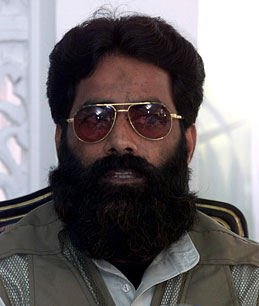
A month after Osama bin Laden’s death, one of the men tipped to succeed him as leader of al-Qaeda is believed to have been eliminated by a CIA-operated drone strike on Friday. U.S. and Pakistani officials say that they are increasingly certain that Ilyas Kashmiri, the head of the “313 Brigade” affiliated with the global terror organization, was slain in South Waziristan. His followers are vowing revenge against the U.S. Full confirmation, officials say, will only come from a DNA test. Caution is a necessity: Kashmiri was reported killed once before, only to resurface.
If he is indeed dead, the killing of Kashmiri will be a major success for the U.S. in its attempts to eliminate senior al-Qaeda and Taliban figures hiding in Pakistan’s tribal areas along the Afghan border. Kashmiri rose to prominence as a leader of the Harakat-ul-Jihad al-Islami militant organization that carried out a bombing in the Indian city of Pune. In more recent years, he has grown close to al-Qaeda and is suspected to have played a major role in the Mumbai massacre in November 2008 and a number of attacks within Pakistan. Some suspect he was behind last month’s attack on a naval base in Karachi. Parts of Kashmiri’s biography remain murky. Former CIA analyst Bruce Riedel wrote that Kashmiri was a former Pakistan army commando — an allegation denied by a senior Pakistani military official.
It is unclear whether Friday’s attack received Pakistan’s assistance. When Secretary of State Hillary Clinton paid a brief visit to Islamabad on May 27, she carried a list of five top militant leaders Washington would like to pursue with Pakistan’s help. Kashmiri was on the list. The others were Afghan Taliban leader Mullah Omar, bin Laden’s deputy Ayman al-Zawahiri, the North Waziristan warlord Sirajuddin Haqqani and Atiya Abdul Rahman, the Libyan operational commander of al-Qaeda. Given the bloodshed he has caused on their soil, Pakistan has very powerful reasons for wanting Kashmiri dead: he has allegedly been behind a series of deadly attacks on Pakistani security forces — including the one on a Karachi naval base, according to the journalist Syed Saleem Shahzad, whose body was recently discovered after a controversial disappearance.
The Kashmiri slaying may also boost the CIA’s case for maintaining the current, near daily pace of drone strikes within Pakistan’s tribal areas. The day before the strike, there was a debate among senior U.S. officials on whether to slow down the covert program, the Wall Street Journal reported. While all officials supported the program, some argued that less frequent strikes would help Washington win greater cooperation with the Pakistanis. Since mid-March, the Pakistani security establishment has been calling for all drone strikes to end.
With Kashmiri’s death, that argument will have been weakened. While drone strikes principally target militants fighting across the border in Afghanistan, Kashmiri is the latest in a series of prominent militant leaders who attack Pakistani targets to have been cut down. Baitullah Mehsud was eliminated by a drone strike in August 2009. His chief strategist, Qari Hussain Mehsud, was also killed in a drone strike. Little has been heard from his successor, Hakimullah Mehsud, in several months.